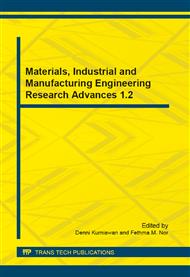[1]
El-Shekeil YA, Sapuan SM, Abdan K, Zainudin ES. Influence of fiber content on the mechanical and thermal properties of Kenaf fiber reinforced thermoplastic polyurethane composites. Materials & Design. 2012; 40: 299-303.
DOI: 10.1016/j.matdes.2012.04.003
Google Scholar
[2]
Rozman HD, Ahmadhilmi KR, Abubakar A. Polyurethane (PU)—oil palm empty fruit bunch (EFB) composites: the effect of EFBG reinforcement in mat form and isocyanate treatment on the mechanical properties. Polymer Testing. 2004; 23: 559-65.
DOI: 10.1016/j.polymertesting.2003.11.004
Google Scholar
[3]
Rozman HD, Tay GS. The effects of NCO/OH ratio on propylene oxide-modified oil palm empty fruit bunch-based polyurethane composites. Journal of Applied Polymer Science. 2008; 110: 3647–54.
DOI: 10.1002/app.28881
Google Scholar
[4]
Rozman HD, Tay GS, Abubakar A, Kumar RN. Tensile properties of oil palm empty fruit bunch–polyurethane composites. European Polymer Journal. 2001; 37: 1759-65.
DOI: 10.1016/s0014-3057(01)00063-5
Google Scholar
[5]
Mat Amin KA, Haji Badri K. Palm-based bio-composites hybridized with kaolinite. Journal of Applied Polymer Science. 2007; 105: 2488–96.
DOI: 10.1002/app.25536
Google Scholar
[6]
Rozman HD, Yeo YS, Tay GS, Abubakar A. The mechanical and physical properties of polyurethane composites based on rice husk and polyethylene glycol. Polymer Testing. 2003; 22: 617-23.
DOI: 10.1016/s0142-9418(02)00165-4
Google Scholar
[7]
Bledzki AK, Zhang W, Chate A. Natural-fibre-reinforced polyurethane microfoams. Composites Science and Technology. 2001; 61: 2405-11.
DOI: 10.1016/s0266-3538(01)00129-4
Google Scholar
[8]
Bakare IO, Okieimen FE, Pavithran C, Abdul Khalil HPS, Brahmakumar M. Mechanical and thermal properties of sisal fiber-reinforced rubber seed oil-based polyurethane composites. Materials & Design. 2010; 31: 4274-80.
DOI: 10.1016/j.matdes.2010.04.013
Google Scholar
[9]
Özgür Seydibeyoğlu M, Oksman K. Novel nanocomposites based on polyurethane and micro fibrillated cellulose. Composites Science and Technology. 2008; 68: 908-14.
DOI: 10.1016/j.compscitech.2007.08.008
Google Scholar
[10]
Wilberforce S, Hashemi S. Effect of fibre concentration, strain rate and weldline on mechanical properties of injection-moulded short glass fibre reinforced thermoplastic polyurethane. Journal of Materials Science. 2009; 44: 1333-43.
DOI: 10.1007/s10853-008-3233-6
Google Scholar
[11]
Vajrasthira C, Amornsakchai T, Bualek-Limcharoen S. Fiber-matrix interactions in aramid-short-fiber-reinforced thermoplastic polyurethane composites. Journal of Applied Polymer Science. 2003; 87: 1059-67.
DOI: 10.1002/app.11484
Google Scholar
[12]
Correa RA, Nunes RCR, Filho WZF. Short fiber reinforced thermoplastic polyurethane elastomer composites. Polymer Composites. 1998; 19: 152-5.
DOI: 10.1002/pc.10086
Google Scholar
[13]
El-Shekeil Y, Sapuan S, ABDAN K, Zainudin E, AL-SHUJA'A# O. Effect of pMDI isocyanate additive on mechanical and thermal properties of Kenaf fibre reinforced thermoplastic polyurethane composites. Bull Mater Sci. 2012; 35.
DOI: 10.1007/s12034-012-0403-6
Google Scholar
[14]
El-Shekeil Y, Sapuan S, Khalina A, Zainudin E, Al-Shuja'a O. Effect of alkali treatment on mechanical and thermal properties of Kenaf fiber-reinforced thermoplastic polyurethane composite. Journal of Thermal Analysis and Calorimetry. 2012; 109: 1435-43.
DOI: 10.1007/s10973-012-2258-x
Google Scholar
[15]
El-Shekeil YA, Salit MS, Abdan K, Zainudin ES. Development of a new kenaf bast fiber-reinforced thermoplastic polyurethane composite. BioResources. 2011; 6: 4662-72.
DOI: 10.4028/www.scientific.net/kem.471-472.297
Google Scholar
[16]
Sapuan S, Pua F-l, El-Shekeil Y, AL-Oqla FM. Mechanical properties of soil buried kenaf fibre reinforced thermoplastic polyurethane composites. Materials & Design. (2013).
DOI: 10.1016/j.matdes.2013.03.013
Google Scholar
[17]
Y. A. El-Shekeil SMS, A. Khalina, E. S. Zainudin, O. M. Al-Shuja'a. Influence of chemical treatment on the tensile properties of kenaf fiber reinforced thermoplastic polyurethane composite. eXPRESS Polymer Letters. 2012; 6: 1032–40.
DOI: 10.3144/expresspolymlett.2012.108
Google Scholar
[18]
Vriesmann LC, Teófilo RF, Lúcia de Oliveira Petkowicz C. Extraction and characterization of pectin from cacao pod husks (Theobroma cacao L. ) with citric acid. LWT - Food Science and Technology. 2012; 49: 108-16.
DOI: 10.1016/j.lwt.2012.04.018
Google Scholar


